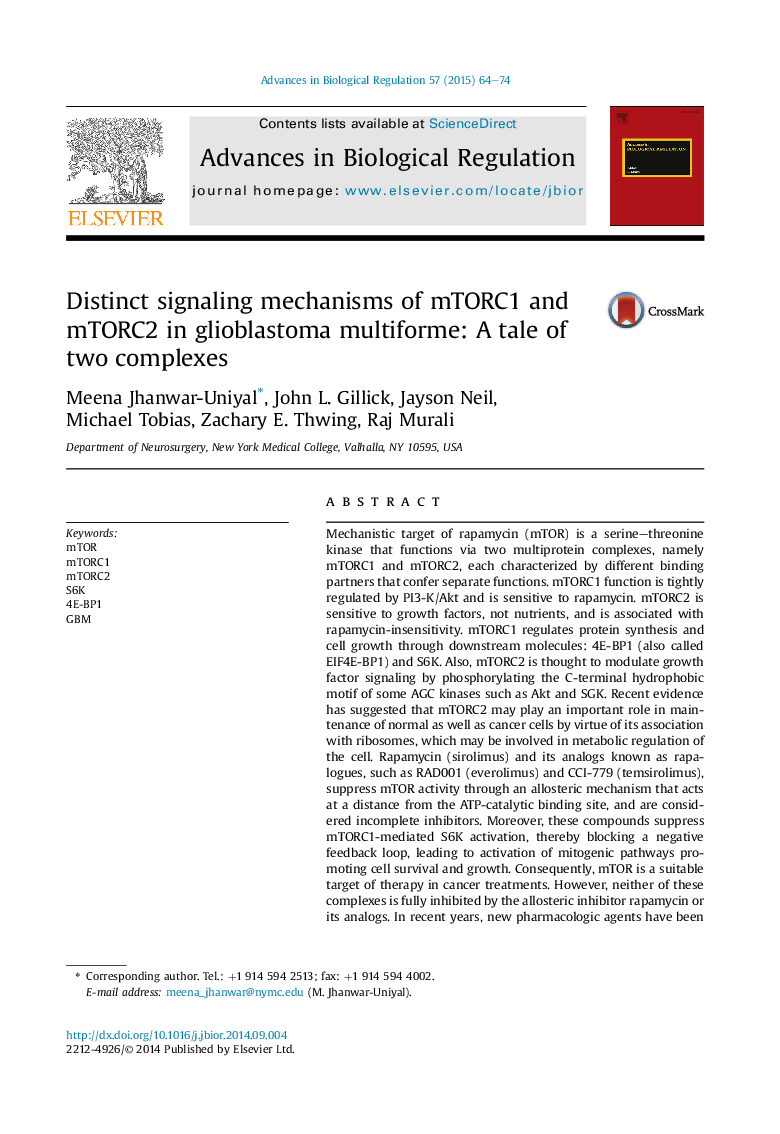| کد مقاله | کد نشریه | سال انتشار | مقاله انگلیسی | نسخه تمام متن |
|---|---|---|---|---|
| 8288078 | 1535874 | 2015 | 11 صفحه PDF | دانلود رایگان |
عنوان انگلیسی مقاله ISI
Distinct signaling mechanisms of mTORC1 and mTORC2 in glioblastoma multiforme: A tale of two complexes
دانلود مقاله + سفارش ترجمه
دانلود مقاله ISI انگلیسی
رایگان برای ایرانیان
موضوعات مرتبط
علوم زیستی و بیوفناوری
بیوشیمی، ژنتیک و زیست شناسی مولکولی
زیست شیمی
پیش نمایش صفحه اول مقاله

چکیده انگلیسی
Mechanistic target of rapamycin (mTOR) is a serine-threonine kinase that functions via two multiprotein complexes, namely mTORC1 and mTORC2, each characterized by different binding partners that confer separate functions. mTORC1 function is tightly regulated by PI3-K/Akt and is sensitive to rapamycin. mTORC2 is sensitive to growth factors, not nutrients, and is associated with rapamycin-insensitivity. mTORC1 regulates protein synthesis and cell growth through downstream molecules: 4E-BP1 (also called EIF4E-BP1) and S6K. Also, mTORC2 is thought to modulate growth factor signaling by phosphorylating the C-terminal hydrophobic motif of some AGC kinases such as Akt and SGK. Recent evidence has suggested that mTORC2 may play an important role in maintenance of normal as well as cancer cells by virtue of its association with ribosomes, which may be involved in metabolic regulation of the cell. Rapamycin (sirolimus) and its analogs known as rapalogues, such as RAD001 (everolimus) and CCI-779 (temsirolimus), suppress mTOR activity through an allosteric mechanism that acts at a distance from the ATP-catalytic binding site, and are considered incomplete inhibitors. Moreover, these compounds suppress mTORC1-mediated S6K activation, thereby blocking a negative feedback loop, leading to activation of mitogenic pathways promoting cell survival and growth. Consequently, mTOR is a suitable target of therapy in cancer treatments. However, neither of these complexes is fully inhibited by the allosteric inhibitor rapamycin or its analogs. In recent years, new pharmacologic agents have been developed which can inhibit these complexes via ATP-binding mechanism, or dual inhibition of the canonical PI3-K/Akt/mTOR signaling pathway. These compounds include WYE-354, KU-003679, PI-103, Torin1, and Torin2, which can target both complexes or serve as a dual inhibitor for PI3-K/mTOR. This investigation describes the mechanism of action of pharmacological agents that effectively target mTORC1 and mTORC2 resulting in suppression of growth, proliferation, and migration of tumor and cancer stem cells.
ناشر
Database: Elsevier - ScienceDirect (ساینس دایرکت)
Journal: Advances in Biological Regulation - Volume 57, January 2015, Pages 64-74
Journal: Advances in Biological Regulation - Volume 57, January 2015, Pages 64-74
نویسندگان
Meena Jhanwar-Uniyal, John L. Gillick, Jayson Neil, Michael Tobias, Zachary E. Thwing, Raj Murali,